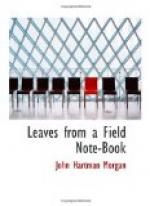At the Machine-gun School they do things on a larger scale, and Wren’s could teach them nothing in the art of cramming. The Instructor reckons to put his class of 200 officers and men through a six months’ course in a fortnight. There is need for it. The Germans started this war with eleven machine-guns (it is now anything from twenty to forty) to a battalion. We started with two. For years they have enlisted, trained, and paid a special class of men to man them. Consequently we had a great deal of leeway to make up. We are making it up, hand over fist, thanks to the Instructor, one of the most brilliant and devoted officers I know, and a man who spends his nights in inventing or perfecting improvements. He has got a pocket edition of a machine-gun made of tempered steel and weighing only 27 lb., as against our old one, which is of gun-metal and weighs 58 lb.—a material difference when it is a question of an advance. The new one, he explains somewhat illogically, with paternal pride, can be carried into action “like a baby.” Having decided to give it a trial we carried it tenderly to a quarry and proceeded to “feed” it with a belt of cartridges. The Instructor set up a small stick against the bank of a gravel quarry and returned and adjusted the tangent-sight at 100 on the standard. He got the fore-sight and back-sight in a line on the stick, seized the traversing-handles, released the safety-catch, and pressed the button with his right thumb with the persistency of a man who cannot make the waiter answer the electric bell. “Tap—tap—tap.” There was a series of explosions as though the sparking plug of a motor-bicycle was playing tricks. The target danced like a thing possessed. It hopped and skipped and curtsied under that deadly stream of bullets. Then he slowly swept that gravel bank with the traversing handles till the pebbles jumped like hailstones. “I think she’ll do,” he remarked appreciatively as he folded up the tripod.
The R.E. is the Army’s school of technology. To do a survey or make a bridge or lay a telephone is all in the day’s work. But your sapper is a man of ideas, and is for ever seeking out new inventions. So he has turned his attention to chemistry, and “R.E.” has a chemical corps which has put aside the blow-pipe and the test-tube at home to come out and study the applied chemistry of war. Just now they are engaged in discovering the most effective method of laying noxious gases. Copper vessels of ammonia in a trench to disperse the gas when it gets there are all very well, but by that time you may have more pressing attentions of the enemy to engage you; the thing is to prevent the gas getting there. Hence ingenious minds are considering how to project with a spray something upon the advancing fog which will bring it to earth in the form of an innocuous compound. Spray that something over the parapet, and if you can spray it far enough and wide enough you may precipitate the deadly green and brown mists into chlorides or bromides which will be as harmless as bleaching-powder and not less salubrious.




